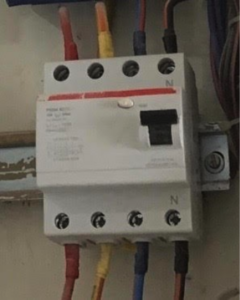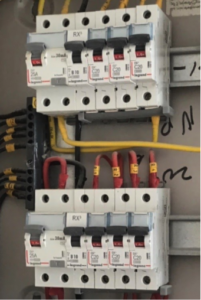RCCB & its importance
The author of this blog is Dinesh, a trained and certified home inspector working at HomeInspeKtor. You can get in touch with him here.
Electricity is something that every one of us is exposed to 24X7! With it, comes its own hazards to human life and the property in the event of any eventualities. 2 major two risks with the electricity is electrocution & fire hazard which cannot be neglected.
This is where Residual Current Circuit Breaker (RCCB) comes in the picture, a safety device used in the electrical circuits. It is a current sensing device which automatically measures and disconnects the electrical circuit when a fault occurs in the circuit or the current exceeds the rated sensitivity of the circuit.
Principle of RCCB:
The RCCB works on the principle of Kirchhoff’s law, which states that in any given circuit, the incoming current must be equal to the outgoing current. So, the RCCB compares the difference in current values between the live and neutral wires. Basically in a circuit, the current flowing through the live must be the same as that of flowing in neutral wire. In case of a fault in a circuit, there is reduction of current flow in neutral, and this differential between the two current is known as residual current. The purpose of RCCB is to sense this fault current and it triggers a trip thereby isolating the circuit.
Classifications of RCCB:
There are two types of RCCBs available: 2-pole RCCB & 4-Pole RCCB.

4-pole RCCB
This is used in a three phase (3-P) supply connection which has 3 live wires & one neutral wire as shown.
Sensitivity of RCCB:
RCCB is measured by sensitivity factor, any small change in residual current. The human body is able to sustain an electric shock to the extent of 30 mA. Upto 10 mA, it may just evoke a prickling (tingling) sensation post which may lead to muscular contraction and further may lead to respiratory paralysis at ~30 mA current. The RCCB ranges from smaller residual current 30 mA to higher residual current 300 mA.
It is important to note that RCCB, a safety device needs to be installed in every home to prevent the shocks and fire hazards from the circuits or the appliances that we are using.
Hope you enjoyed reading this blog about home inspections written by the best home inspection company in Bangalore – HomeInspeKtor and get to know about all the issues such as seepage, electrical faults, hollow tiles etc found in a new home.
Subscribe to our YouTube channel https://www.youtube.com/channel/UCmS9kFLcKjThKm2Q2QKIUfA or visit www.homeinspektor.com/testimonials to look at all the awesome testimonials for HomeInspeKtor.
Still not convinced about a home inspection or just want to learn more – head over to our extensive blog at www.homeinspektor.com/blog to learn more about the topic of home inspections.
Get in touch NOW
home inspection, home inspector, home inspection tools, home inspection services, home inspection blog, home inspection bangalore, home inspection chennai, home inspector bangalore, home inspector chennai, house inspection, house inspector, house inspection tools, house inspection services, house inspection blog, house inspection bangalore, house inspection chennai, house inspector bangalore, house inspector chennai, flat inspection, apartment inspection, pre occupation inspection, third party inspection, home inspection charges, house inspection charges, homeinspektor, home inspection india, house inspection india, flat inspection india, apartment inspection india.
